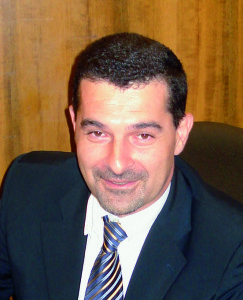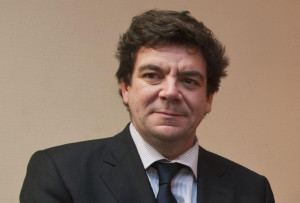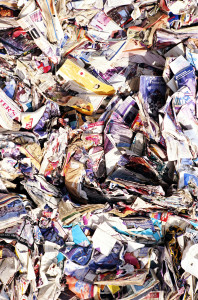by Chiara Italia
How is domestic paper collected? How are the materials that come from separate waste collection and those that come directly from the industry defined? When is it considered waste and when secondary raw materials? And, to come full circle, how is waste managed in paper industry? Here is a survey about secondary raw materials and waste in the paper field that compares the experiences of Italy, France and Spain.
What is waste and what isn’t? How does waste collection work, which is the supply tool of one of the most strategic raw materials for the paper industry? Waste management regulations are not the same in all European countries, while going in the same direction. For this reason we wanted to compare the standards used in Italy, Spain and France interviewing their main referents: Massimo Medugno, director at Assocarta for Italian paper industry, David Barrio, director of recycling at Aspapel for Spanish paper industry and Noël Mangin, General Delegate at Procelpac for French paper industry.

Separate waste collection in Italy and Spain
Let’s start from Italy. Here paper is collected separately from other materials: « which is very important for the paper industry because it means starting, at least in theory, from the best conditions» says Massimo Medugno, a consequence also of Italian legislation which provides for simplified procedures for the selection and treatment of paper collection and that has strengthened this collection method».
What comes out from this collection? «Waste, material that still has dirt, «says Medugno. «Italian regulation establishes that a material defined as waste may be considered a secondary raw material – not waste then – if it reaches certain quality standards established by law «. So it is clear that what is collected is waste; when it passes through selection and treatment – basically in a recovery platform – paper from waste becomes secondary raw material: «It is a pioneering system of end of waste, which means that under certain conditions a material is no longer waste. Even the paper that comes from industrial circuits is still waste, then to be considered non-waste – a secondary raw material – it must be processed in a recovery platform that must be authorized according to the regulations in force it being understood that it must be recycled in paper industry.
In Spain too «the paper from households is always collected separately from other materials», says David Barrio. «We have blue bins on the streets and they receive all the paper products (graphic and packaging) except beverage cartons».
However, if in Italy the platform, besides having an important logistic function, is used to transform waste into secondary raw material, in Spain this transformation role is entrusted to the pulper: «paper is always waste until it is introduced at the pulper and recycled into recycled pulp: the pulper is considered the final recycling point», explains Barrio.

Multi-waste collection in France
France proposes a different multi-material model, as explained by Noël Mangin: «In France the predominant collection system for recyclable household waste is comingled but with a specific and independent flow for glass. The main part of the collection system is a door to door method and secondly by bring system in particular in the rural and semi-rural areas. We are waiting for the European decision concerning the outcome of the waste status, but for the moment all used paper and board products are under the waste status. Therefore, paper and board waste is under the Basil convention (green list) and circulates without restriction in Europe».
Regulation on by-products: still open forum
Now let’s talk about scraps or shavings which come from paper industries: are they waste or by-products? Are they sent directly to the paper mill or do they have intermediaries? In Italy, explains Massimo Medugno, «shavings – which represent 10-15% collection – are an exception to the rules: they aren’t regulated by the waste legislation because they have sure employment as they are used by industry without preliminary transformations, and they represent the only case in which the materials from the processing industry go directly back to the paper mill. That’s why they are by-products and not waste, and they don’t have intermediaries unless there’s a logistic need. In this regard Italy has correctly transposed complete Community legislation: in fact, when the Community policy of ‘”end of waste” will be defined, the context will change for sure. «
In Spain, shavings from paper mills are considered waste: «all the paper coming directly from the industry (shavings and cuttings) are legally considered waste just like any other grade from the EN643. There are no specific rules for post-consumer versus pre-consumer paper regarding the waste consideration», explains Barrio, also pointing out that: «We are now under the discussion of the by-products scheme in Spain, but the issue is very tricky and the results uncertain. The idea of opur Env. Ministry is to have specific by-products legislation for specific waste flows, but this is not going to be easy.
In France it exists a legislation for by-products in conformity with the European Waste Directive and it is the responsibility of the producers to qualify their products and eventually propose to the Public Authorities in charge, to validate this qualification.«In fact, we have three different channels», explains Noël Mangin: the flow of shavings and cuttings which have the possibility to be qualified as by-products (for the packaging sector, these products are exchanged directly between producers and converters whereas for graphic cuttings generally it exists an intermediary); the flow of industrial and commercial used packaging which is treated and traded by waste paper merchants and/or waste operators; the flow of municipal used paper and board products which are collected and sorted by waste companies under the responsibility of the municipalities, legally in charge of this».

Intermediation system
Now we would like to understand, in different countries, if the industry system works through intermediaries, if it goes directly to companies or if the companies participate in the selection platforms.
In Spain, some of the shavings and cuttings pass through intermediaries and some goes directly to the paper mills using reverse logistics.
In France, to be exact, there are two EPR systems (Eco-Emballages for household packaging and Ecofolio for graphic products): these two eco-organisms are registered (approved) by the Public Authorities and sign contracts with the municipalities. These systems are strictly organized with a clear role of each partner, a strict traceability and control, a good identification of these products by reference to a common standard defined within the agreement», tells Noël Mangin, who points out: «A lot of contracts to assure the take-back are directly signed between municipalities and paper-mills: in this channel, the role of the traders is relatively weak, the different partners in the chain playing an active role to modify physically the products.
In Italy, instead, the intermediation system is considered very important, widespread and practiced by companies. For some years we have seen greater interest by some companies that would also like to cover the management phase prior to use in the paper industry; evidently because having control on raw materials supply has become a strategic issue for companies. Some paper mills are in fact trying to integrate upstream, perhaps buying recovery platforms. «Definitely», confirms Medugno, there is an increased focus on the topic of supply because since Italy has become a waste paper exporter, the function of intermediaries has been even more understood: if a company is more related to a territory industrial policy, its policy will be of greater stability and increased programming and industrial perspective, while when there is strong export, the intermediary tends to do arbitrage between domestic and export market. And the goal of industry is to have constant raw materials at reasonable prices, which is why some companies are looking more carefully at waste management group before using it in paper mills. But this is contrasted by institutional permissions, «a very rigid licensing system, very severe as it should be, so harsh to treat all waste equally».
The collection of recycled paper
So far we’ve talked about environment regulations and players of waste collection. But what is the collection rate of recycled paper? Can it grow further? Let’s take some data.
In Spain «the collection rate in 2012 was 74%, and we think it can grow more and we estimate that an additional 1 million tons of paper could be saved from the landfills and reintroduced into the recycling loop», states Barrio.
In France the rate of global recycling is 70%, divided into: recycling rate for packaging (89%), for household packaging (67%), for graphic papers (51%).
In Italy the collection rate is around 54-55%, with wide margins of growth, per capita collection stands at about 50 kg, while nine out of ten packaging are recycled: «collection capacity is greater than use capacity, then export is a result due to this situation where collection is greater than use».
Towards a «recycling society»
«If some companies could improve their efficiency in terms of energy and could have energy recovery systems for their own waste, perhaps the situation might change, and the use of paper for pulping might grow also in Italy,» says Medugno. Our thinking is directed to the fact that recycled material can become a strategic resource both within Italy and the European Union with the aim of achieving a recycling society, enabling waste to become an opportunity, an opportunity of development also in the territory». A recycling society governed by at least two principles: «first, the principle of proximity, according to which we should prefer using waste collection sites that are as close as possible to recoverable waste because the more we handle waste, the more environmental benefits of waste recycling are lost. The second principle says that environmental standards should be the same between EU Countries and non-EU Countries: but this is the case in which there is a rule but not a clear method for control».
Principle of proximity
But how much paper for pulping is exported every year and where does it go? Are there national initiatives to control the amount of pulp exported abroad to prevent raw materials from leaving indiscriminately the country before being processed and therefore with lower added value?
According to Italian data, about one and a half million pulp is exported, of which 80% to China. In Spain, around 700,000 tons per year are exported, basically to China. In France since 2011 there has been 12% increase of pulp export to the Asian countries, which corresponds to approximately 20% total exports.
Proximity recycling is currently subject of large discussions. Among the initiatives that have been pursued in Europe, let’s see how France, Spain and Italy have dealt with the issue.
Spain is the country that has encouraged more the principle of proximity, with a new law on waste which was approved last November 29th, 2012, in support of the legitimacy of Recycling Made in Europe, a law that gives Spanish generators of recyclable waste materials powers to decide on the final destination of their waste: «Thanks to proximity recycling», says Barrio, «the European recycling society turns the 6 ton of waste that each European citizen produces in a year into an opportunity to create wealth and green employment in Europe, in a sustainable, efficient and environmentally responsible manner, thereby giving value to the significant efforts made across Europe in recent years in terms of waste recovery. By developing a European Recycling Society through measures such as this new Spanish law, the EU estimates that over 400,000 jobs could be created in Europe between now and 2020.
France instead has developed a system that allows complete freedom of choice, however by offering incentives to those who will choose proximity: «a reference has been introduced in the eco-organisms agreement and recently in the Ecofolio’s agreement», explains Noël Mangin. «Each Eco-organism makes report about the final destination of the products for recycling and controls the reality of final recycling. The debate concerned the definition of proximity and conformity with the competition rules. The French paper industry proposed to define proximity as area where exists (at minimum) three final recyclers using significant and regular quantities of concerned products for recycling and recommend to implement a proportional incitation to recycle in this area. That means total freedom to choose the destination but proposes incentives (bonus in the ERP systems) to choose proximity in defined conditions».
In Italy, the principle of proximity for the use of materials already exists in theory; it just needs implementation, as explains Medugno: «it would be enough to revive this principle in next Anci-Conai agreement (which must be renewed next year) that will set the terms for the withdrawal of packaging waste, thus giving precise reference to the community. Concerning control on environmental standards, we must find a system that should turn the collection of pulp paper in an opportunity for development, for green economy, and Europe should create a harmonic and test system that should be the same for all Member States».
To come full circle. Paper scraps
Paper waste management: what happens to pulp scraps? How are they managed? Paper mills are equipped for their disposal; do they have their own systems? How is it used and in what percentages?
In Spain «at the moment, around half of the pulper rejects are landfilled. The other half is under an energy recovery process. But the problem is that the regional and local authorities are very reluctant to provide the necessary authorization to build and operate the recovery plant», states Barrio.
Same problem in Italy, only in different percentages: «pulp waste goes in landfills or energy recovery (25%), which is a very low opportunity and this does not happen; it could happen if we were to follow the example of other European countries, such as Germany or France, which is one way to help recycling. We just aren’t able to do it, not for lack of regulations or technologies, «says Medugno.
In France, then, Pulper waste is managed by the paper mill: «The concrete situations are different, certain factories are equipped to dispose them, to valorize them, others use the services of waste operators. The French paper industry demands a differentiated fiscal treatment for this pulper waste regarding the waste without treatment», states Noël Mangin.

